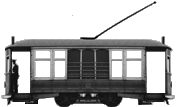Perth Electric Tramway Society
Operator of
Western Australia's Heritage Tramway
Whiteman Park - Perth - Western Australia

Restoration of Perth 15

Perth B class 12 in the 1920s, heading north in Barrack Street on the Mount Lawley-North Perth service, bound for Walcott Street.
Perth [second] B-class trams were built in several batches between 1904 and 1919, with a final total of 54 of this style in the fleet. The first was #40, which was the first tram built in Western Australia, all earlier trams having been imported. The bodies of the earlier cars 1 to 30 [original A and B classes] were subsequently re-built to this type.
The B-class design featured:
- A single truck ie 4 wheels, with 2 motors
- A length of 29 feet
- Seating for 32 passengers, and standing-room [officially] for 16: 8 inside and 8 on the rear platform
- Removable side windows, making the car adaptable for summer or winter use
- Weather blinds to give protection from sun or rain
- Low side body panels, so that passenger seating was level with the bottom of the window opening
- Braking with handbrake only
B-class trams were common on the South Perth tramways; outside peak hours they were often operated by one man, who both drove the car and collected fares. The transport provided by the tramway played a significant role in the development of the South Perth district between the wars, and this is being recognised by the restoration of a B-class tram as a static exhibit.
The tram chosen for this project was B-class 15. Its restoration is being undertaken by PETS, in association with the South Perth City Council and the South Perth Historical Society, and on completion the tram will be prominently displayed in South Perth.
The body of #15 spent many retirement years as a play-room in Kelmscott, where it was well protected. After its retrieval by PETS a number of years ago, it was placed in under-cover storage.
The restoration team was faced with a long and painstaking task: the roof was in good condition, but some other sections had deteriorated, and many wooden parts had to be replaced, using patterns from good sections or from another B-class tram.
Work on the sides:

One side had to be completely removed.

Temporary roof supports in place.

Sides rebuilt ...

...and repainted.
Work on the end platforms:

Renewing supports.

Bumper in place.

Renewal of floor timbers

Starting to replace the apron.
The superlative quality of the workmanship in the rebuilding process is evident from these images.